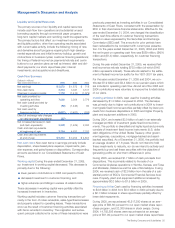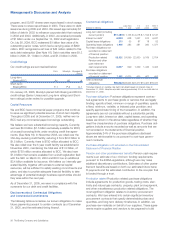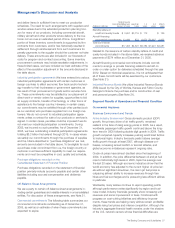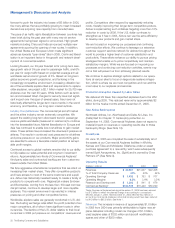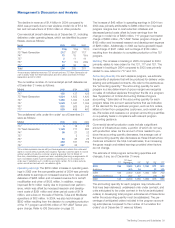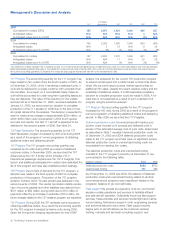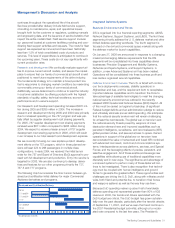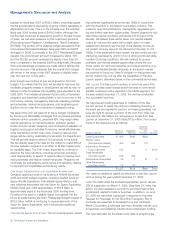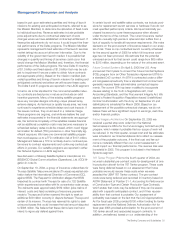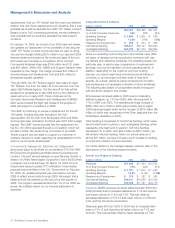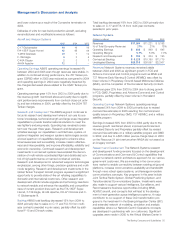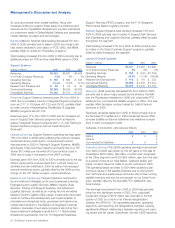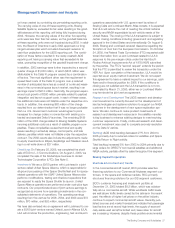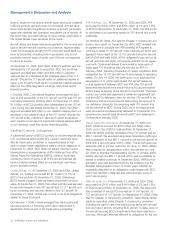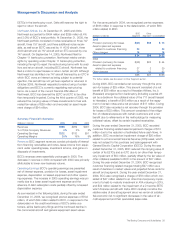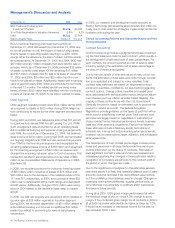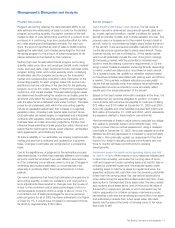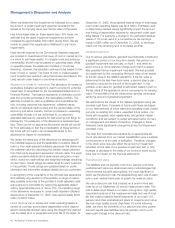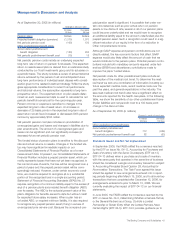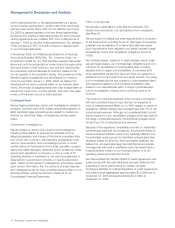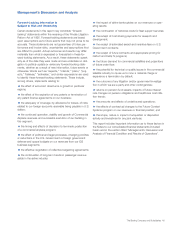Boeing 2005 Annual Report Download - page 37
Download and view the complete annual report
Please find page 37 of the 2005 Boeing annual report below. You can navigate through the pages in the report by either clicking on the pages listed below, or by using the keyword search tool below to find specific information within the annual report.
Management’s Discussion and Analysis
and lower volume as a result of the Comanche termination in
2004.
Deliveries of units for new-build production aircraft, excluding
remanufactures and modifications were as follows:
Aircraft and Weapon Systems
2005 2004 2003
C-17 Globemaster 16 16 16
F/A-18E/F Super Hornet 42 48 44
T-45TS Goshawk 10 7 12
F-15E Eagle 6 3 4
C-40A Clipper 2 3 1
AH-64 Apache 12 3 –
Operating Earnings A&WS operating earnings increased 4%
between 2004 and 2005 even though revenues were stable. In
addition to continued strong performance, the 767 Tanker pro-
gram CSR&D effort in 2005 was reduced as compared to 2004
and operating earnings in 2004 were negatively impacted by
the charges discussed above related to the USAF Tanker pro-
gram.
Operating earnings grew 15% from 2003 to 2004 partly due to
the revenue growth mentioned above and partly due to signifi-
cant performance improvements from contract close-out activ-
ity and lean initiatives in 2004, partially offset by the 2004 767
Tanker charges.
Research and Development The A&WS segment continues to
focus its research and development where it can use its cus-
tomer knowledge, technical strength and large-scale integration
capabilities to provide transformational solutions to meet the
war fighter’s enduring needs. Spending has remained consis-
tent over the past three years. Research and development
activities leverage our capabilities in architectures, system-of-
systems integration and weapon systems technologies across
a broad spectrum of capabilities designed to enhance situa-
tional awareness and survivability, increase mission effective-
ness and interoperability, and improve affordability, reliability and
economic ownership. Continued research and development
investments in unmanned systems have enabled the demon-
stration of multi-vehicle coordinated flight and distributed con-
trol of high-performance unmanned combat air vehicles.
Research and development in advanced weapons technologies
emphasizes, among other things, precision guidance and multi-
mode targeting. Research and development investments in the
Global Tanker Transport Aircraft program represent a significant
opportunity to provide state-of-the-art refueling capabilities to
domestic and international customers. Other research and
development efforts include upgrade and technology insertions
to network-enable and enhance the capability and competitive-
ness of current product lines such as the F/A-18E/F Super
Hornet, F-15E Eagle, AH-64 Apache, CH-47 Chinook and C-
17 Globemaster III.
Backlog A&WS total backlog decreased 12% from 2004 to
2005 primarily due to sales on C-17 and F/A-18 from multi-
year contracts awarded in prior years, partially offset by addi-
tional F-15 and Chinook orders.
Total backlog decreased 19% from 2003 to 2004 primarily due
to sales on C-17 and F/A-18 from multi-year contracts
awarded in prior years.
Network Systems
(Dollars in millions) 2005 2004 2003
Revenues $11,264 $11,221 $««9,198
% of Total Company Revenues 21% 21% 18%
Operating Earnings $«««««638 $«««««969 $«««««645
Operating Margins 5.7% 8.6% 7.0%
Research and Development $«««««285 $«««««234 $«««««195
Contractual Backlog $««6,228 $10,190 $11,715
Unobligated Backlog $28,316 $26,097 $22,907
Revenues Network Systems revenues remained stable
between 2004 and 2005 as significant growth in FCS and
Airborne Command and Control programs such as MMA and
737 Airborne Early Warning & Control (AEW&C) was offset by
lower volume in Proprietary, Ground-based Midcourse Defense
(GMD), and the completion of the Homeland Security contract.
Revenues grew 22% from 2003 to 2004 due to strong growth
in FCS, GMD, Proprietary, and Airborne Command and Control
programs, partially offset by lower volume in Homeland
Security.
Operating Earnings Network Systems operating earnings
decreased 34% from 2004 to 2005 primarily due to revised
cost and fee estimates in 2005 resulting from technical and
quality issues on Proprietary, GMD, 737 AEW&C, and a military
satellite program.
Earnings increased 50% from 2003 to 2004 partly due to the
revenue growth mentioned above; improved performance in
Homeland Security and Proprietary partially offset by revised
cost and fee estimates on a military satellite program and GMD
in 2004; and due to a $55 million pre-tax charge taken in 2003
on the Resource 21 joint venture when NASA did not award us
an imagery contract.
Research and Development The Network Systems research
and development funding remains focused on the development
of Communications and Command & Control capabilities that
support a network-centric architecture approach for our various
government customers. We are investing in the communica-
tions market to enable connectivity between existing air/ground
platforms, increase communications availability and bandwidth
through more robust space systems, and leverage innovative
communications concepts. Key programs in this area include
Joint Tactical Radio System, Global Positioning System, and
Transformational Communications System. Investments were
also made to support various Intelligence, Surveillance, and
Reconnaissance business opportunities including MMA,
AEW&C aircraft, and concepts that will lead to the develop-
ment of next-generation space intelligence systems. A major
contributor to our support of these DoD transformation pro-
grams is the investment in the Boeing Integration Center (BIC)
and extended network of modeling, simulation and analysis
capabilities where our Network-Centric Operations concepts
are developed in partnership with our customers. Significant
upgrades were made in 2005 to the Virtual Warfare Center in
The Boeing Company and Subsidiaries 35


